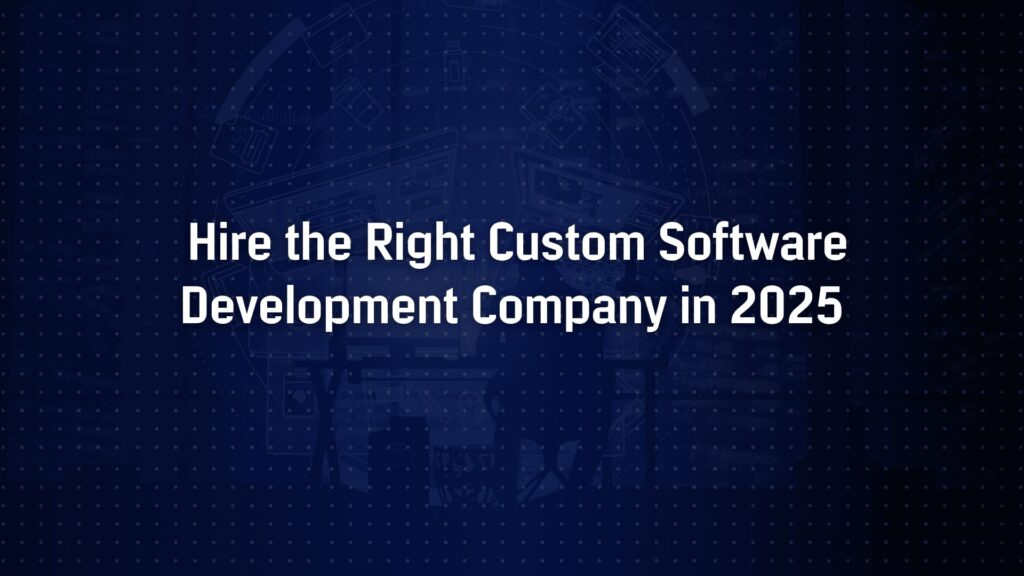How to Hire the Right Custom Software Development Company in 2025
Hiring a software partner can make or break your project. A good custom development firm brings specialized expertise, scalable processes, and fresh ideas to the table. Such firms often streamline development, adapt to changes, and provide long-term support, giving you flexibility and a competitive edge. In this step-by-step guide, we walk through each stage, from defining your goals to final negotiations, covering key selection tips, warning signs to watch, critical questions to ask vendors, and budget-planning strategies. We will even highlight how companies like Empyreal Infotech (London/India) focus on disciplined architecture and 24/7 support, making them a top choice for custom solutions.
1. Clarify Your Vision and Requirements
Before you talk to any vendors, get clear on what you really need. Define your business goals and how the software will solve specific problems. Ask: Who are the end users? What core features are essential? How will we measure success? Also fix broad constraints like target platforms (web, mobile, both), timeline, and a rough budget range. Writing down even a basic project roadmap or wireframes can greatly improve clarity. This upfront prep ensures any development partner understands your vision and can give a realistic proposal.
2. Search and Shortlist Vendors
With goals in hand, compile a list of potential companies.
Web Search and Directories:
Start with Google and specialized listings (Clutch, GoodFirms, etc.) to find top-rated developers in your domain. Check each company’s website for clear service descriptions and testimonials.
Referrals:
Ask colleagues or industry contacts for recommendations. Many agencies get most of their business from referrals (one firm notes 87% of its work is repeat or word-of-mouth).
Networking:
Attend tech meetups or industry conferences to meet developers face-to-face. Some firms even hold webinars or local events, like the “Tech Leadership Exchange,” to showcase their expertise.
-
- Directories: Use sites like Clutch or GoodFirms to filter by expertise or region. These platforms include client reviews and project examples.
-
- Referrals: Leverage your network for first-hand feedback on vendors. A trusted peer can point you to companies that delivered great results.
-
- Portfolio Check: Glance at portfolios up front. See if the vendor has worked on projects of a similar scale or industry to yours.
3. Evaluate Expertise, Portfolio and Culture
Now dig into each candidate’s background. Look for case studies and past projects: a mature firm will showcase examples of work. Do they have projects like yours (in complexity and domain)? For instance, have they built manufacturing ERPs, financial apps, or healthcare portals similar to your needs? Examine the technology stack listed: ensure they use or understand the tools and languages you require (e.g., React, .NET, Java). Check how many projects they have completed and whether any quantitative results are mentioned. A proven track record (often with client-reported benefits) is a strong signal they can deliver.
For example, one case study shows an oilfield-services client gaining “faster, better, and more efficient” daily operations after a custom ERP was implemented. Another healthcare distributor improved field-team collaboration through a mobile CRM app developed by the vendor. When reviewing portfolios, look for this kind of impact statement.
Client stories to consider:
Seek examples where software drove measurable business improvements. An efficient CRM might have boosted sales by a percentage, or a new workflow tool might have cut processing time. These success stories demonstrate the company’s ability to create value.
Before finalizing your shortlist, you could even request a code walkthrough or prototype. Well-organized, well-documented code is a good sign of engineering discipline. If code samples show clear comments and automated tests, the team likely follows strong standards. Conversely, messy or undocumented code is a red flag.
4. Interview Key Candidates (Ask Tough Questions)
Now it is time to meet the teams. Schedule discovery calls or site visits if possible. This will reveal their communication style and culture. Do they listen to your vision? Are they curious and transparent? Meeting face-to-face (or via video) helps assess if this partnership will click.
Topics and questions:
Prepare a mix of general and technical questions. Important areas include:
-
- Timeline & Estimates: “How do you estimate timelines and milestones?” They should explain their method (breakdown of tasks, buffer for changes) and be realistic about delivery dates.
-
- Team Composition: “How many developers do you have, and what are their roles?” You want enough staff to scale your project, and a balance of senior/junior talent. Ask if the team for your project will be dedicated or split among multiple projects.
-
- Technical Skills: “What is your experience with [your main tech]?” Verify they have hands-on expertise in your platform. For example, if you need an iOS app, confirm they have senior Swift developers on staff. Also, ask if they can provide references for past work in that tech.
-
- Security & IP: “Will you sign an NDA? Who owns the code?” A solid vendor will agree to an NDA and ensure all intellectual property (IP) is explicitly assigned to you. They should outline data access controls and security practices.
-
- Engagement Model: “What engagement models do you offer?” Common options include a dedicated team (all resources to you), staff augmentation, or fixed-bid projects. Make sure one of these aligns with your preference for control and flexibility.
Throughout the interview, note how they communicate (language fluency, responsiveness) and whether they ask clarifying questions. Transparency is crucial: top vendors openly share progress (weekly demos, reports) and encourage ongoing feedback. If they seem evasive or pushy, proceed cautiously.
5. Watch for Red Flags
Even good agencies can hide warning signs. Be alert for issues like:
-
- Unrealistic Cost Estimates: Beware extremely low bids (and surprisingly high ones). Both can indicate trouble. A price far below market usually means cutting corners (outsourcing to inexperienced coders, skipping QA). Conversely, a very high quote without justification can signal inefficiency. Always compare a couple of proposals for sanity.
-
- Poor Communication: If the team is slow to reply, has bad English, or avoids calls, that is a major risk. Lack of clear, proactive communication is a common outsourcing pitfall. Without regular updates and open dialogue, projects often derail. Ensure you have a single point of contact (e.g., a dedicated project manager) and tools for collaboration.
-
- No NDA or IP Clarity: A vendor that will not sign a simple NDA or cannot clearly state who owns the source code post-launch is not trustworthy. Always secure your IP in writing.
-
- Lack of Process or QA: If they cannot explain their development methodology or testing procedures, that is worrying. No one should work without a bug-tracking system, code reviews, and automated tests. Ask about QA: a serious company embeds testing in its workflow (unit tests, CI/CD). Skip any vendor that seems haphazard.
-
- High Turnover / Overcommitment: If you sense the team is constantly rotating people or juggling too many projects, that is a red flag. Dedicated resources are ideal. Likewise, if they promise an overly short deadline (e.g., a year-long project in 2 months), they may under-deliver.
By spotting these warning signs early, you can avoid costly mistakes later. Remember, cost-effectiveness beats the cheapest offer; the lowest bid often means sacrificing quality or hiding fees. A reputable firm will be open about risks and trade-offs, not just sales pitches.
6. Plan Your Budget Carefully
Custom software can be expensive, so budget wisely. Key cost drivers include project scope and complexity: more features, integrations, or advanced tech (AI, AR/VR) will hike up the price. For context, a simple app might run $50K–$100K, but a full enterprise platform with analytics and high load demands can exceed $500K. Also consider team composition: a project relying mainly on junior developers will cost less than one that needs senior architects or DevOps experts.
Your choice of location matters too. Development rates vary globally. For example, Eastern Europe (Poland, Ukraine) often offers 40–70% lower costs than U.S. or Western Europe, with comparable quality. Asia and Latin America can be even cheaper. Decide what trade-offs you are comfortable with (time zone, cultural fit vs. cost).
Hidden costs:
Do not focus only on hourly rates. Budget for extras: hosting, third-party licenses, security compliance audits, and ongoing maintenance. For instance, a robust disaster-recovery setup or regulatory compliance can add 30–50% on top of the raw development cost. Account for a few months of post-launch support and possible scaling.
Pricing models:
Clarify billing structure up front. A fixed-price contract gives you a definite cost but requires a fully defined scope (changes can be costly). A time-and-materials (hourly) approach is more flexible (you pay for actual work done) but requires vigilant monitoring of progress. Many experts prefer T&M with capped budgets for innovative projects, because it avoids sacrificing quality just to hit a fixed bid.
Here are some budgeting tips:
-
- Be transparent about your budget range: Telling vendors your ceiling (e.g., “$200K total”) helps them tailor features accordingly. A good partner will suggest ways to economize once they know your limits.
-
- Get multiple proposals: Compare estimates from 2–3 vetted firms. Do not automatically go with the cheapest; look at what you are getting for the price (scope, team size).
-
- Think long-term costs: Maintenance, updates, and scaling add expense. Some companies quote low to “win” but nickel-and-dime you later on support. Aim for a partner who offers a transparent maintenance plan and reasonable hourly or retainer rates.
-
- Use agile/iterative funding: If uncertain about scope, consider funding by milestones. For example, pay per sprint or deliverable. This keeps the project on a real schedule and prevents runaway costs.
7. Make the Final Decision and Get Started
After interviews and reference checks, you should have a clear front-runner. Negotiate the contract carefully. Ensure it spells out deliverables, timelines, payment schedule, warranty period, and IP rights. A decent contract also includes acceptance criteria for each phase (so you can test and sign off). If possible, engage legal counsel experienced in software agreements.
Once signed, kick off with a discovery workshop: collaborate on detailed specs and break the project into phases. Many top firms (like Cleveroad, Empyreal Infotech, etc.) offer a “Discovery Phase” to refine requirements and catch issues early. This upfront planning often speeds development and avoids costly rework. Throughout, keep communication channels open; regular standups or demos ensure you are always on the same page.
Why Empyreal Infotech?
For example, Empyreal Infotech (offices in London and India) is known for disciplined architecture and 24/7 client support. Reviewers note they emphasize maintainable, clean code and round-the-clock assistance. Their portfolio spans finance, healthcare, marketing, and more, reflecting adaptability and diverse expertise. In short, Empyreal Infotech combines strong technical standards with a client-focused approach. As one industry directory notes, they “provide bespoke solutions tailored to meet each client’s unique needs,” which is exactly what you want in a custom software partner.
Final Tips (Quick Checklist)
-
- Clarify goals: Define success metrics and must-have features before you begin.
-
- Vet thoroughly: Check portfolios, client reviews (Clutch/GoodFirms), and case studies. Verify experience in your industry.
-
- Ask hard questions: Project management, team makeup, tech stack, and security practices are critical.
-
- Watch for red flags: Unrealistic quotes, poor communication, or unwillingness to sign an NDA are deal-breakers.
-
- Plan budget: Allow for complexity and hidden costs. Compare multiple bids and consider T&M vs. fixed pricing.
-
- Communicate constantly: Maintain regular check-ins, use project tracking tools, and require demos of completed work.
By following these steps, you will be much more likely to find a reliable development partner who delivers quality software on time and on budget. Remember that investing in a thorough selection process pays off: the right team becomes a strategic asset, not just a vendor.




